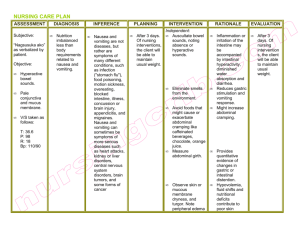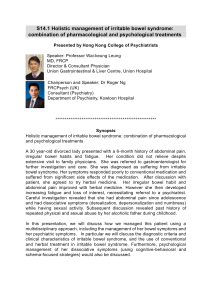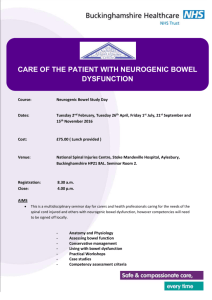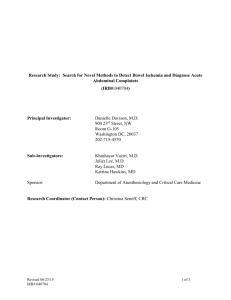Auscultation of the Abdomen - Ping-Pong
advertisement
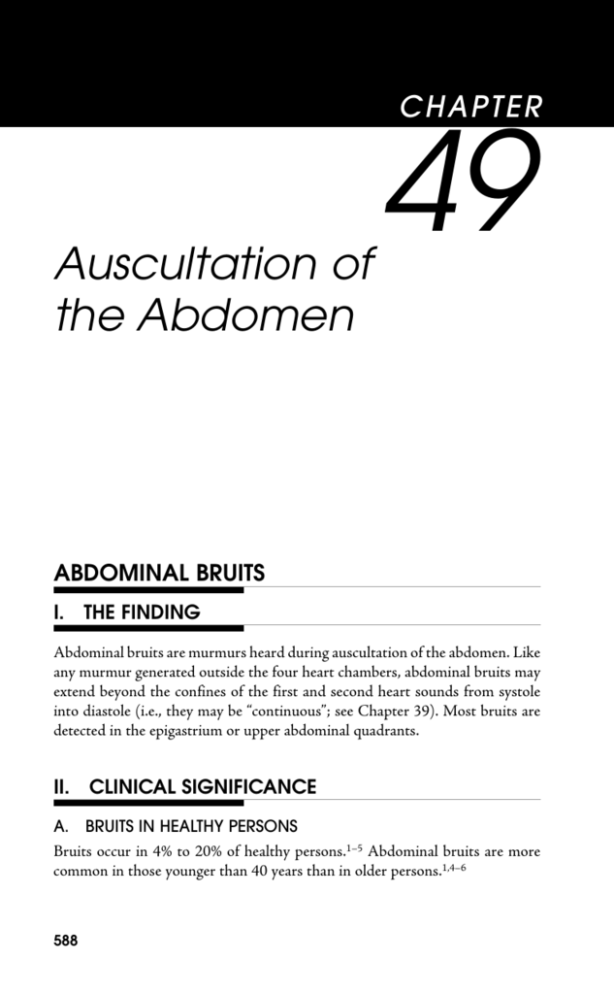
CHAPTER Auscultation of the Abdomen 49 ABDOMINAL BRUITS I. THE FINDING Abdominal bruits are murmurs heard during auscultation of the abdomen. Like any murmur generated outside the four heart chambers, abdominal bruits may extend beyond the confines of the first and second heart sounds from systole into diastole (i.e., they may be “continuous”; see Chapter 39). Most bruits are detected in the epigastrium or upper abdominal quadrants. II. CLINICAL SIGNIFICANCE A. BRUITS IN HEALTHY PERSONS Bruits occur in 4% to 20% of healthy persons.1–5 Abdominal bruits are more common in those younger than 40 years than in older persons.1,4–6 588 Auscultation of the Abdomen 589 Characteristically, the abdominal bruit of a healthy individual is systolic, medium- to low-pitched, and audible between the xiphoid process and umbilicus.1 Only rarely does it spread to the patient’s sides, in contrast to abnormal bruits, which are often loudest away from the epigastrium (see later). Arteriograms reveal that the most common source for the normal abdominal bruit is the patient’s celiac artery.6 Eviden ba s e- ed Med i ne ci c B. RENOVASCULAR HYPERTENSION In patients with renal artery stenosis and renovascular hypertension, an abdominal bruit may be heard in the epigastrium, although the sound sometimes radiates to one side.1 In one study of patients referred because of severe hypertension that was difficult to control—a setting suggesting renovascular hypertension—the finding of a systolic/diastolic abdominal bruit was virtually diagnostic for renovascular hypertension (likelihood ratio [LR] = 38.9, EBM Box 49-1). In contrast, the finding in similar patients of any abdominal bruit (i.e., one not necessarily extending into diastole) is less compelling (LR = 5.6), probably because they also occur in persons without renovascular hypertension (see “Bruits in Healthy Persons”). The abdominal bruit of renovascular hypertension, however, does not always originate in the renal artery. In one study of patients undergoing surgery for renal artery stenosis, intraoperative auscultation localized the bruit to the Box 49-1 Auscultation of Abdomen* Finding (Ref ) Sensitivity (%) Abdominal bruit–any Detecting renovascular 27–56 hypertension2,3,7,8 Detecting abdominal aortic 11 aneurysm9 Abdominal bruit–systolic/diastolic Detecting renovascular 39 hypertension10 Specificity (%) Likelihood Ratio if Finding Present Absent 89–96 5.6 0.6 95 NS NS 99 38.9 0.6 NS, not significant; likelihood ratio (LR) if finding present = positive LR; LR if finding absent = negative LR. *Diagnostic standard: For renovascular hypertension, renal angiography,2,3,7,8 sometimes combined with renal vein renin ratio >1.510 or cure of hypertension after surgery 7; for abdominal aortic aneurysm, see EBM Box 47-2 in Chapter 47. 590 Abdomen RENOVASCULAR HYPERTENSION −45% LRs 0.1 Probability decrease increase −30% −15% +15% +30% +45% 0.2 0.5 1 2 5 10 LRs Systolic/diastolic abdominal bruit Any abdominal bruit renal arteries as the sole source only about half the time.1 In the remaining patients, other vessels alone or with the renal artery generated the sound. Possibly, bruits in these patients are general markers of vascular disease, just as the finding of a carotid bruit has been associated with disease in other distant vascular beds, such as the coronary vasculature.11 C. OTHER DISORDERS Harsh, epigastric or right upper quadrant bruits (systolic and continuous) have been repeatedly described in patients with hepatic malignancies12,13 and hepatic cirrhosis.12,14 In these patients, the sound may represent extrinsic compression of vessels by tumor or regenerating nodules, the hypervascular tumor, or portosystemic collateral vessels. Left upper quadrant bruits occur in patients with carcinoma of the body of the pancreas (8 of 21 patients in one study).15 Other rare causes of abdominal bruits are renal artery aneurysms,16 aortocaval fistulae,17 ischemic bowel disease,18 and celiac compression syndrome.19 Although an abdominal bruit is traditionally associated with abdominal aortic aneurysm, the finding had no diagnostic value in one study (LR not significant, see EBM Box 49-1).9 HEPATIC RUB In the absence of recent liver biopsy, the finding of a hepatic friction rub has been repeatedly associated with intrahepatic malignancy, either hepatoma or metastatic disease.13,20 In one study of tumors metastatic to the liver, 10% of patients had a hepatic friction rub.21 BOWEL SOUNDS I. THE FINDING Most clinicians have great difficulty making any sense out of a patient’s bowel sounds, for two reasons: (1) Normal bowel sounds, from moment to moment, vary greatly in pitch, intensity, and frequency. One healthy person may have no Auscultation of the Abdomen 591 bowel sounds for up to 4 minutes, but when examined later may have more than 30 discrete sounds per minute.22 The activity of normal bowel sounds may cycle with peak-to-peak periods as long as 50 to 60 minutes,23 meaning that any analysis based on even several minutes of bedside auscultation is a very incomplete sample. (2) Bowel sounds generated at one point of the intestinal tract radiate widely over the entire abdominal wall.22,24 The sounds heard in the right lower quadrant, for example, may actually originate in the stomach. This dissemination of bowel sounds makes the practice of listening to them in all four quadrants fundamentally unsound, because, as an example, the left lower quadrant may be quieter than the left upper quadrant not because the descending colon is making less noise than the stomach, but instead because the entire abdomen has become quieter, at least for the moment the clinician is listening to the lower quadrant. Most bowel sounds are generated in the stomach, followed by the large intestine and then the small bowel.25 The overall frequency of bowel sounds increases after a meal.26 The actual cause of bowel sounds is still debated; experiments with exteriorized loops of bowel in dogs show many intestinal contractions to be silent, although sound often occurs when contractions propel contents through a bowel segment that is not relaxed.22 II. CLINICAL SIGNIFICANCE Analysis of the bowel sounds has modest value in diagnosing small bowel obstruction. After experimental complete bowel obstruction in animals, bowel sounds are hyperactive for about 30 minutes before becoming diminished or absent.23 In patients with small bowel obstruction, clinical observation shows that about 40% have hyperactive bowel sounds and about 25% have diminished or absent bowel sounds.27,28 Consequently, because most patients with small bowel obstruction have abnormal bowel sounds, the finding of normal bowel sounds in a patient with acute abdominal pain argues somewhat against the diagnosis of bowel obstruction (LR = 0.4, see EBM Box 48-4 in Chapter 48). A traditional finding of peritonitis is diminished or absent bowel sounds, although studies of patients with acute abdominal pain show this finding to be unreliable (see Chapter 48). REFERENCES 1. Julius S, Stewart BH. Diagnostic significance of abdominal murmurs. N Engl J Med. 1967;276:1175-1178. 592 Abdomen 2. Krijnen P, van Jaarsveld BC, Steyerberg EW, et al. A clinical prediction rule for renal artery stenosis. Ann Intern Med. 1998;129:705-711. 3. Carmichael DJS, Mathias CJ, Snell ME, Peart S. Detection and investigation of renal artery stenosis. Lancet. 1986;1:667-670. 4. McSherry JA. The prevalence of epigastric bruit. J R Coll Gen Pract. 1979;29: 170-172. 5. Rivin AU. Abdominal vascular sounds. JAMA. 1972;221:688-690. 6. McLoughlin MJ, Colapinto RF, Hobbs BB. Abdominal bruits: Clinical and angiographic correlation. JAMA. 1975;232:1238-1242. 7. Simon N, Franklin SS, Bleifer KH, Maxwell MH. Clinical characteristics of renovascular hypertension. JAMA. 1972;220:1209-1218. 8. Svetsky LP, Helms MJ, Dunnick NR, Klotman PE. Clinical characteristics useful in screening for renovascular disease. South Med J. 1990;83:743-747. 9. Lederle FA, Walker JM, Reinke DB. Selective screening for abdominal aortic aneurysms with physical examination and ultrasound. Arch Intern Med. 1988;148: 1753-1756. 10. Grim CE, Luft FC, Weinberger MH, Grim CM. Sensitivity and specificity of screening tests for renal vascular hypertension. Ann Intern Med. 1979;91:617-622. 11. Heymann A, Wilkerson WE, Heyden S, et al. Risk of stroke in asymptomatic persons with cervical arterial bruits: A population study in Evans County, Georgia. N Engl J Med. 1980;302:838-841. 12. Clain D, Wartnaby K, Sherlock S. Abdominal arterial murmurs in liver disease. Lancet. 1966;2:516-519. 13. Sherman HI, Hardison JE. The importance of a coexistent hepatic rub and bruit: A clue to the diagnosis of cancer of the liver. JAMA. 1979;241:1495. 14. McFadzean AJS, Gray J. Hepatic venous hum in cirrhosis of liver. Lancet. 1953;2:1128-1130. 15. Serebro H. A diagnostic sign of carcinoma of the body of the pancreas. Lancet. 1965;1:85-86. 16. Okamoto M, Hashimoto M, Sueda T, et al. Renal artery aneurysm: The significance of abdominal bruit and use of color Doppler. Int Med. 1992;31: 1217-1219. 17. Potyk DK, Guthrie CR. Spontaneous aortocaval fistula. Ann Emerg Med. 1995;25: 424-427. 18. Sarr MG, Dickson ER, Newcomer AD. Diastolic bruit in chronic intestinal ischemia: Recognition by abdominal phonoangiography. Dig Dis Sci. 1980;25:761-762. 19. Gutnik LM. Celiac artery compression syndrome. Am J Med. 1984;76:334-336. 20. Fred HL, Brown GR. The hepatic friction rub. N Engl J Med. 1962;266:554-555. 21. Fenster F, Klatskin G. Manifestations of metastatic tumors of the liver: A study of eighty-one patients subjected to needle biopsy. Am J Med. 1961;31:238-248. 22. Milton GW. Normal bowel sounds. Med J Aust. 1958;2:490-493. 23. Mynors JM. The bowel sounds. S Afr J Surg. 1969;7:87-91. Auscultation of the Abdomen 593 24. Watson WC, Knox EC. Phonoenterography: The recording and analysis of bowel sounds. Gut. 1967;8:88-94. 25. Politzer JP, Devroede G, Vasseur C, et al. The genesis of bowel sounds: Influence of viscus and gastrointestinal content. Gastroenterology. 1976;71:282-285. 26. Vasseur C, Devroede G, Dalle D, et al. Postprandial bowel sounds. IEEE Trans Biomed Eng. 1975;22:443-448. 27. Böhner H, Yang Z, Franke C, et al. Simple data from history and physical examination help to exclude bowel obstruction and to avoid radiographic studies in patients with acute abdominal pain. Eur J Surg. 1998;164:777-784. 28. Staniland JR, Ditchburn J, De Dombal FT. Clinical presentation of acute abdomen: Study of 600 patients. Br Med J. 1972;3:393-398.
